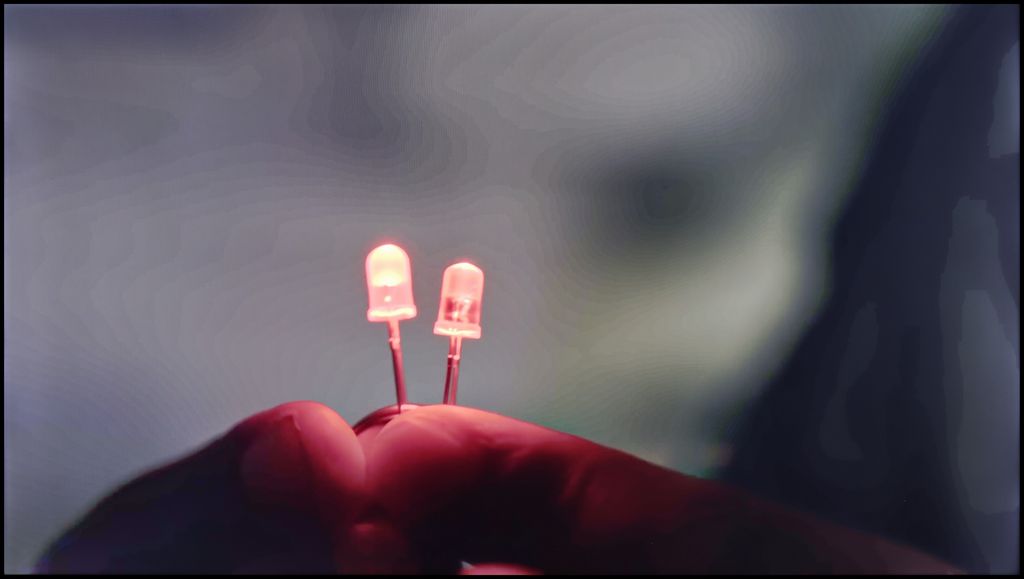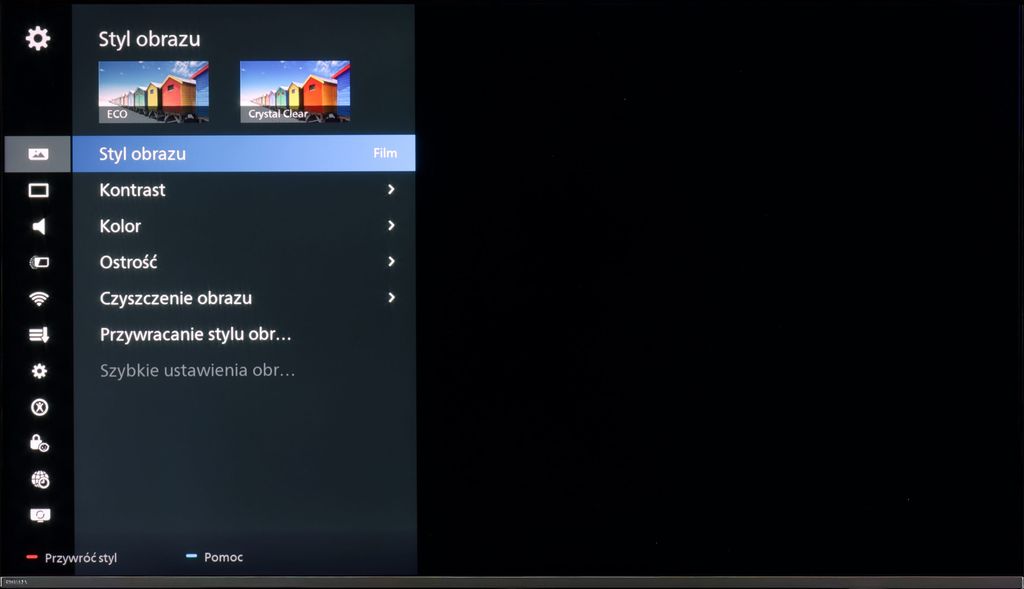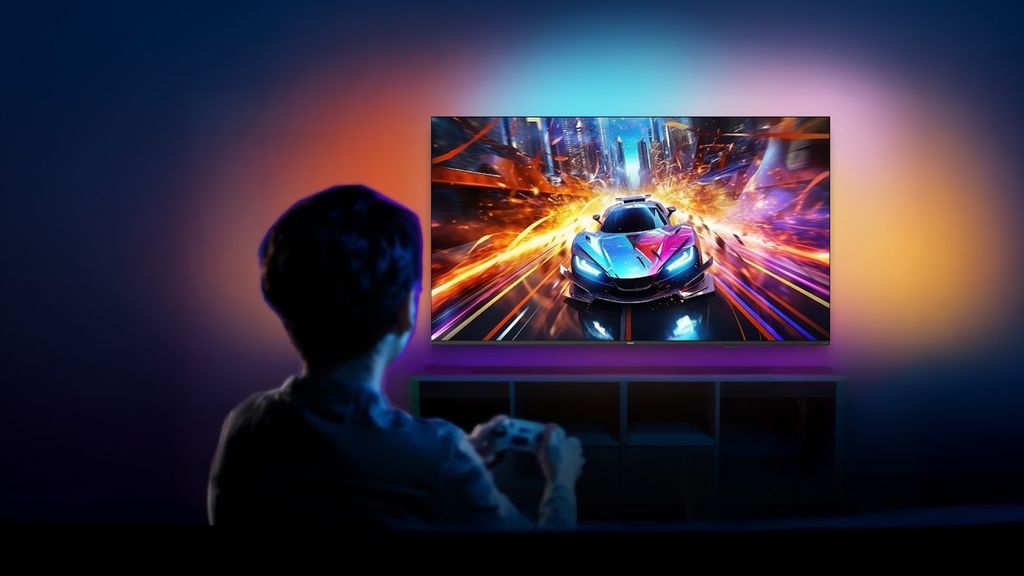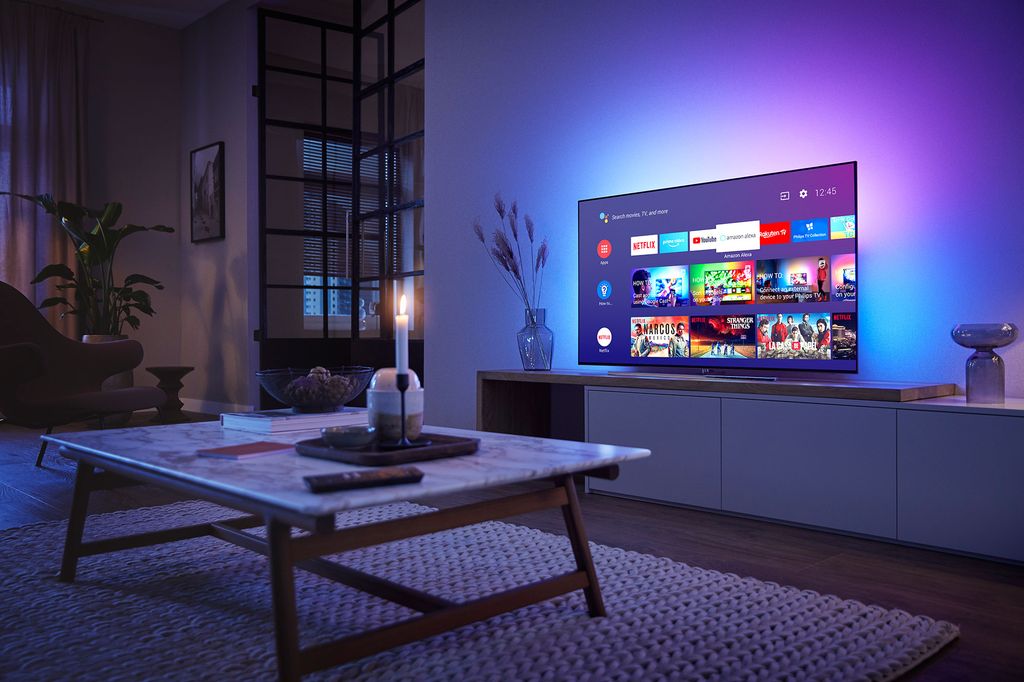4K Ultra HD resolution (3840 x 2160): Offers four times the resolution of Full HD, providing a sharp and clear image with rich detail.
Ambilight technology: The three-sided Ambilight system emits a glow that adapts to the content displayed on the screen, creating a more immersive viewing experience.
Support for HDR10, HDR10+, and HLG: Support for various HDR formats provides better contrast and more accurate color representation, resulting in a more realistic image.
Titan OS operating system: An intuitive and fast Smart TV system that allows access to popular streaming applications and customization of the interface.
Dolby Atmos technology: Delivers spatial sound, creating the sensation of surrounding audio and enhancing the quality of multimedia content reception.
HDMI 2.1 ports: Three HDMI ports enable connection to modern devices with fast data transfer and support for advanced features.
Gamer features: Support for VRR (Variable Refresh Rate) provides smoother gameplay with reduced latency, which is advantageous for gamers.
Wi-Fi and Bluetooth connectivity: Provides wireless connection to the internet and other devices, enhancing the functionality of the TV.
- Matching (Score)
- Our verdict
- Competing TVs
- TV appearance
- Where to buy
- Contrast and black detail
- HDR effect quality
- Factory color reproduction
- Color reproduction after calibration
- Smoothness of tonal transitions
- Image scaling and smoothness of tonal transitions
- Blur and motion smoothness
- Console compatibility and gaming features
- Input lag
- Compatibility with PC
- Viewing angles
- Daytime performance
- TV features
- Apps
- Playing files from USB
- Sound
- Panel details
Philips PUS8359 (VA) Review
PUS8349 / PUS8359
Available screen sizes:
Diagonal with a different matrix: , ,

Complete the survey to find out the result
Panel type: LCD VA Refresh rate: 60Hz Brand: PHILIPS Resolution: 3840x2160 System: Titan OS Model year: 2024
PHILIPS PUS8359/12 - Our verdict
5.4
Overall rating
Philips PUS8359 in 50" is a straightforward television, but offers sufficient features to satisfy many consumers. Its most notable feature, which is common across the brand, is the Ambilight backlighting. At this price point, this addition is certainly valuable and may be a deciding factor for many buyers. While it’s unrealistic to expect a flawless picture in this price range, some models offer more, and in our view, this television is one of them.
In particular, the quality of tonal transitions, colour reproduction after calibration, and performance when connected to a computer stand out. With low input lag, casual gaming is quite enjoyable. However, the unit does have its drawbacks. The low luminance in HDR content and limited DCI-P3 colour gamut coverage are noteworthy issues. That said, the dynamic tone mapping feature works efficiently.
While the contrast and black levels are not exceptional, they are certainly better than those found in units with IPS/ADS panels. The operating system is one of the better ones, though it is still being developed and lacks many features, which we will address in a dedicated section. Additionally, it doesn’t offer as broad an app library as its competitors, though this should change soon.
Who is the PUS8359 for? It is suited for anyone seeking a balance between quality and price.
Advantages
Colour reproduction after calibration
Dynamic tone mapping function - recovers details that are too bright for the television
Smooth tonal transitions
Very good cooperation with computers and consoles - low input lag, chroma 4:4:4
Disadvantages
Low brightness of HDR materials
Missing a significant portion of essential applications
Poor viewing angles
Movies and series in UHD quality
5.2
Classic TV, YouTube
5.4
Sports broadcasts (TV and apps)
4.5
Gaming on console
6.4
TV as a computer monitor
6.0
Watching in bright light
4.7
Utility functions
5.3
Apps
6.2
Sound quality
6.1
Complete the survey to find out what fits your preferences
PHILIPS PUS8359/12 - Competing TVs in this price range
PHILIPS PUS8359/12 - TV appearance
HDMI inputs: 3 x HDMI 2.0, 0 x HDMI 2.1 Outputs: Toslink (Optical audio), eARC (HDMI), ARC (HDMI), Mini-Jack (Headphones) Network Interfaces: Wi-Fi 2.4GHz, Wi-Fi 5GHz, Ethernet (LAN) 100Mbps
Build quality: Average
Stand type: Legs
Bezel color: Graphite








Stand: Fixed
Flat design: No
Accessories: Stand
Buy at the best price
Select size:
PHILIPS PUS8359/12 - Contrast and black detail
5.6/10
Local dimming function: No

Result
4,400:1

Result
4,950:1

Result
4,500:1

Result
5,650:1

Result
3,800:1
Visibility of details in the lights:

The Philips PUS8359/12 in the 50-inch version is equipped with a VA panel, which is worth highlighting as the manufacturer often uses them interchangeably with IPS/ADS panels, depending on the screen size. This is particularly important in terms of contrast and black levels, which are key factors in assessing picture quality. The panel features direct backlighting (Direct LED), but it lacks local dimming support, a characteristic that is expected given the device’s price range.
Nonetheless, the choice of VA panel allows for superior black levels and contrast compared to the IPS/ADS panels that lack advanced backlighting systems. The television’s simple construction also benefits the visibility of detail in dark areas. In our first test scene from Oblivion, the black levels were quite good, with impressive light separation, a feat that even more expensive models sometimes struggle with. A second test frame from The Revenant also appeared quite solid. While some blooming from the backlighting is noticeable due to construction limitations, the details in darker scenes remain well-defined and difficult to fault. However, it must be noted that the black levels could still be deeper.
Halo effect and black detail visibility:
PHILIPS PUS8359/12 - HDR effect quality
4.6/10
Supported formats: HDR10, HDR10+, HLG Color gamut coverage: DCI P3: 83.0%, Bt.2020: 61.0%
Luminance measurements in HDR:

Result
281 nit

Result
280 nit

Result
324 nit

Result
290 nit

Result
320 nit
The Philips PUS8359 has low brightness levels; however, dynamic tone mapping works surprisingly well, making it worth praising!
Scene from the movie “Pan” (about 2800 nits)

Scene from the movie “Billy Lynn” (about 1100 nits)

The maximum brightness results in HDR materials have impacted the performance of the Philips PUS8359/12 in our demanding test scenes. The scene from the film Billy Lynn loses its main advantages—high brightness and deep black levels. The entire image is significantly darkened, leading to issues with detail in the blacks and creating dark patches in places. There is also a problem with skin tones due to the TV's limited coverage of a wide colour gamut. The tested TV performed noticeably better in the second scene from The King's Speech. Despite some overall darkening of the image, due to insufficient brightness and the lack of a popular HDR format with dynamic metadata, the overall tonal quality was very good, and in this case, the tested TV deserves praise.
HDR luminance chart:
HDR luminance
In HDR scenes requiring high brightness or good tone mapping, despite the Philips PUS8359/12 not offering high brightness levels, it surprised us positively, with details being very well visible. When a signal with dynamic metadata was provided, the situation did not change significantly, but there was a slight improvement in clarity, particularly in distant scenery. Therefore, the dynamic tone mapping feature in the tested unit deserves recognition and a high rating.
Static HDR10

Factory color reproduction
4/10
The best factory mode for fidelity to the source material was the "Film" mode, which we used during our tests. As with all factory modes in televisions, it has flaws, and we’ll now examine what went wrong in both SDR and HDR materials. In both cases, the white balance showed an excessive dominance of green and red, resulting in a yellowish tint across the entire image. This caused issues such as yellowed whites and problems with skin tones. This was clearly illustrated on the "ColourChecker" palette, where each tested sample shifted towards warmer equivalents. The foundation of the image lies in contrast and black levels, represented by gamma charts and the EOTF curve. Looking at the gamma chart, we saw a real rollercoaster, with both elevated and lowered gamma. The elevated gamma caused visibility issues in blacks, while the lowered gamma led to a dramatic drop in contrast. In this context, the EOTF curve performed significantly better, as it only mildly brightened the image.
Color reproduction after calibration
5/10
Philips offers a wide range of image calibration tools in its higher-end and more affordable models. We used these tools, but the process was not as straightforward as many might expect. While we adjusted the white balance, significantly improved the gamma, and refined the EOTF curve in both SDR and HDR content, the deltaE errors remained extremely high. Several factors contribute to this situation, including the limited coverage of the DCI-P3 colour gamut and the unit's maximum brightness in HDR materials.


PHILIPS PUS8359/12 - Smoothness of tonal transitions
7.4/10
The fluidity of gradation in the Philips PUS8359 is quite good. Almost every scene maintains smooth tonal transitions. The most challenging scene, the second one from the film The Green Knight, didn’t prove to be a "deal-breaker" and demonstrated that the television handles it excellently within its price range. The only minor issue we noticed was in the darkest scenes, where some occasional fluidity problems were visible, but these were relatively selective. Overall, we rate the fluidity of tonal transitions very highly. It is important to note, however, that this feature is not available in HDR materials.








Image scaling and smoothness of tonal transitions
6/10
Smooth transition function

Image without overscan on the SD signal

In this paragraph, we will take a look at two functionalities. We will once again look at the function responsible for tonal transitions, but we will also check how the television handles image scaling. The option responsible for smooth gradation is called "Distortion Reduction." As we have established, it quite effectively smooths out imperfections. However, we need to point out two things: we cannot enable it for HDR material and it blurs details in films.
The tested television cannot boast the best image scaling. There is a noticeable overall blurriness of the image, but what is worse, it blurs details. This is particularly visible on the branches and the model's hair. Additionally, a characteristic white halo can often be seen surrounding characters.
PHILIPS PUS8359/12 - Blur and motion smoothness
3.8/10
Maximum refresh rate of the panel: 60Hz
Film motion smoothing option: No
Blur reduction option: No

The Philips PUS8359 is not the best choice for watching sports. This is primarily due to the absence of even a basic motion smoothing feature, which given the price point, is not entirely surprising. Additionally, the television uses a VA panel, which, while offering high contrast, is not known for its sharpness or fast response times. As demonstrated in our analysis, fast-moving scenes often result in noticeable blurring, a common issue with this type of panel.
Although it is not an ideal option, the TV can be used for sports viewing with some compromises, particularly regarding motion sharpness. It's also worth noting that films are prone to stuttering since the TV lacks any form of motion smoothing, even the most basic functionality.
Blur (native resolution, maximum refresh rate):



PHILIPS PUS8359/12 - Console compatibility and gaming features
4.7/10
ALLM: Yes
VRR: Yes
VRR range: 60
Dolby Vision Game Mode: No
Correct implementation of HGIG: No
1080p@120Hz: No
1440p@120Hz: No
4K@120Hz: No
Game bar: Yes


Unsurprisingly the Philips PUS8359/12 offers only the most basic support for consoles. When connecting a console, users can rely on features like VRR (Variable Refresh Rate) and ALLM (Auto Low Latency Mode). VRR is particularly commendable, as even some higher-end models can struggle with this functionality.
A noteworthy addition is the implementation of a dedicated GameBar, which allows for on-the-fly adjustments without needing to exit the game, minimising unnecessary distractions. This feature also provides options to tailor gameplay for individuals with disabilities, making it a highly commendable inclusion.



PHILIPS PUS8359/12 - Input lag
10/10
After connecting to a console the measured input lag was excellent, leaving nothing to criticise. At both FHD and 4K settings, we recorded latencies of 12ms, while adding HDR to the higher resolution further reduced the lag to 11ms. Each of these results is highly commendable, ensuring gameplay is virtually free from delays at the controller-to-screen level.
| SDR | HDR | Dolby Vision |
|---|---|---|
| 1080p60: 12 ms | 2160p60: 11 ms | |
| 2160p60: 12 ms |

PHILIPS PUS8359/12 - Compatibility with PC
6/10
Chroma 444 (maximum resolution and refresh rate): Yes
Font clarity: Good
Readability of dark text and shapes: Good
Input lag in PC mode (4K, maximum refresh rate): 11ms
Max refresh rate: 60Hz
G-Sync: Yes
Connecting the Philips PUS8359 to a computer poses no significant issues for gaming. The latency remains excellent, with 4K HDR settings delivering an 11ms input lag—an imperceptible value along the eye-screen-mouse line. Additionally, the tested TV supports 4:4:4 chroma, ensuring that working with text files is seamless and free from visual discomfort.
PHILIPS PUS8359/12 - Viewing angles
3.4/10
Brightness drop at an angle of 45 degrees: 65%
The brightness drop at a 45-degree angle is 65%, indicating that even a slight deviation from the centre of the screen can result in noticeable discomfort due to colour degradation and image fading. This is a common characteristic of most VA panels that lack wide-viewing angle coatings.
PHILIPS PUS8359/12 - Daytime performance
4.7/10


Panel finish: Satin
Reflection suppression: Good
Black levels during daytime: Good
The Philips PUS8359/12 matrix has a satin finish. This finish effectively minimises light reflections, allowing for relatively comfortable TV viewing during the day. It is worth noting that the maximum brightness of the TV in SDR content is around 320 nits, which is a respectable result, particularly as the brightness is maintained even with 100% white screen fill.
Panel brightness
Average luminance SDR
Philips PUS8359 (VA): 318 cd/m2
PHILIPS PUS8359/12 - TV features
5.3/10
System: Titan OS
System performance: Poor
- HDMI inputs: 3 x HDMI 2.0, 0 x HDMI 2.1
- Outputs: Toslink (Optical audio), eARC (HDMI), ARC (HDMI), Mini-Jack (Headphones)
- Network Interfaces: Wi-Fi 2.4GHz, Wi-Fi 5GHz, Ethernet (LAN) 100Mbps
- TV reception: DVB-T, DVB-T2, DVB-S, DVB-S2, DVB-C
Classic features:
Recording to USB (terrestrial TV): No
Recording programming: No
Picture in Picture (PiP): No
RF remote control (no need to aim at the screen): RF
Backlit remote control: Yes
Teletext: Yes
Audio only mode: Yes
Bluetooth headphones support: No
Simultaneous Bluetooth headphones & TV audio: No
Smart features:
AirPlay: No
Screen mirroring (Windows Miracast): Yes
Voice search: Yes
Voice search in native language: No
Ability to connect a keyboard and mouse: Yes






It is impossible not to first mention the most distinctive feature of the manufacturer's televisions: the multicoloured Ambilight backlighting. Positioned on the rear casing, this feature adjusts colours to match the on-screen content, often enhancing the immersive experience.
The operating system powering the Philips PUS8359/12 is Philips' proprietary TitanOs. Compared to the manufacturer's Google TV models, TitanOs is significantly more closed and limited in its application resources. For instance, important apps such as Apple TV, MAX, Canal+, and Player are absent. This closed nature also extends to basic functionalities; users cannot program recordings or record content to USB.
Apple device users may find the lack of AirPlay functionality disappointing, as it prevents seamless screen streaming. On the positive side, users can connect a keyboard and mouse for easier navigation of the TV menu. Wired headphone support is available, and audio can simultaneously play through the TV’s speakers when headphones are connected. However, the remote control uses IR rather than Bluetooth, which feels outdated.
In summary: TitanOs comes with several limitations, especially for users relying on a wide range of streaming platforms. It is better suited for those sticking to the "holy trinity" of Netflix, YouTube, and CDA.
Sound connection options
HDMI audio:
Other audio outputs:
Toslink: Yes
Stereo (Mini-Jack): Yes
Wireless audio:
Supported audio formats (external HDMI eARC audio):
Dolby Digital Plus 7.1: Yes
Dolby True HD 7.1: Yes
Dolby Atmos in Dolby Digital Plus (JOC): Yes
Dolby Atmos in Dolby True HD: Yes
DTS:X in DTS-HD MA: Yes
DTS-HD Master Audio: Yes
Senior accessibility
Numeric keyboard on TV: Yes
Font size adjustment: No
Audio description: No
PHILIPS PUS8359/12 - Apps
6.2/10























PHILIPS PUS8359/12 - Playing files from USB
8/10

| Maximum photo resolution: | Supported photo formats: |
|---|---|
The default media player built into the Philips PUS8359/12 offers a broad range of capabilities, though it does have its limitations. It supports nearly all video formats except Dolby Vision and the less common .asf format. However, a notable drawback is the lack of support for the H.265 HEVC codec at high bitrates.
For photos, the player performs adequately but does not support some widely used resolutions and formats, such as HEIC, commonly found on Apple devices. The strongest performance is seen with audio playback, where the player excels and leaves little to criticise.
Unfortunately, due to the limitations of the TitanOs system, there is no option to expand the player's functionality, leaving users restricted to what the manufacturer has provided.
PHILIPS PUS8359/12 - Sound
6.1/10
-
Maximum volume
Supported codecs
(TV speakers)
Dolby Digital Plus 7.1
Dolby True HD 7.1
Dolby Atmos in Dolby Digital Plus (JOC)
Dolby Atmos in Dolby True HD
DTS:X in DTS-HD MA
DTS-HD Master Audio
The audio system built into the Philips PUS8359/12 features a basic 2x 10 W speaker configuration. Unsurprisingly, such a setup does not offer much in terms of performance. However, if the volume remains below 50% of its maximum level, the audio quality is satisfactory and unlikely to draw criticism.
For a significantly improved experience, it is highly recommended to connect even an affordable soundbar. Thanks to the range of codecs supported by the manufacturer, including Dolby Atmos and DTS-HD Master Audio, external audio devices will undoubtedly enhance the overall sound quality.
Acoustic Measurements
No acoustic data
PHILIPS PUS8359/12 - Panel details
Software version during testing: V246.003.000.131
Image processor: nie wiem ale chyba tredriper
Subpixel Structure:

Backlight Type: White LED

Founder and originator of the "ChooseTV" portal

Journalist, reviewer, and columnist for the "ChooseTV" portal
See articles related to Philips PUS8359 (VA):
10/2/2025
1/29/2025
2/26/2025











